|
|
|
|
Contact:
Suzuki DR650 Tires Page

Your choice of tires can drastically increase or hinder your traction on dry roads, wet roads, snow, ice, mud, dirt, etc.
The standard tire size on new and old DR650s are:
Suzuki recommends use of a genuine Suzuki Tire:
You can also run 130/90-17 Trail Wings in the rear.
Tire Sizing and Conversion Tools
Tire Sizing Chart
| Front Tires | Rear Tires | |||||
| Metric | Alpha | Inch | Metric | Alpha | Inch | |
|
80/90 |
MH90 |
2.50/2.75 |
110/90 | MP85 | 4.00/4.75 | |
| 90/90 | MJ90 | 2.75/3.00 | 120/90 | MR90 | 4.50/4.75 | |
| 100/90 | MM90 | 3.25/3.50 | 130/80 | -- | 5.00/5.10 | |
| 110/90 | MN90 | 3.75/4.00 | 130/90 | MT90 | 5.00/5.10 | |
| 120/80 | -- | 4.25/4.50 | 140/80 | -- | 5.50/6.00 | |
| 120/90 | MR90 | 4.25/4.50 | 140/90 | MU90 | 5.50/6.00 | |
| 130/90 | MT90 | 5.00/5.10 | 150/80 | MV85 | 6.00/6.25 | |
| 150/90 | MV85 | 6.00/6.25 | ||||
| 160/80 | -- | 6.80/7.00 | ||||
| 180/55 | -- | 7.00/7.25 | ||||
| 200/60 | -- | 7.90/8.00 | ||||
| 230/50 | -- | 9.50 | ||||
Speed Rating Chart
| Motorcycle Speed Ratings | Maximum Design | Test Speed |
| J Type | 62 | 100 |
| N Type | 87 | 140 |
| P Type | 94 | 150 |
| S Type | 112 | 180 |
| H Type | 130 | 210 |
| V Type | 149 | 240 |
| Z Type | 149+ | 240+ |
|
Tires with 2.00, 2.25 & 2.50 nominal section widths are rated for 75 mph. |
||
|
Load Index (LI) Rating Chart |
|||||||||||||
| LI | lbs. | LI | lbs. | LI | lbs. | LI | lbs. | LI | lbs. | ||||
| 20 | 176 | 33 | 254 | 46 | 375 | 59 | 536 | 72 | 783 | ||||
| 21 | 182 | 34 | 260 | 47 | 386 | 60 | 551 | 73 | 805 | ||||
| 22 | 187 | 35 | 267 | 48 | 397 | 61 | 567 | 74 | 827 | ||||
| 23 | 193 | 36 | 276 | 49 | 408 | 62 | 584 | 75 | 853 | ||||
| 24 | 198 | 37 | 282 | 50 | 419 | 63 | 600 | 76 | 882 | ||||
| 25 | 204 | 38 | 291 | 51 | 430 | 64 | 617 | 77 | 908 | ||||
| 26 | 209 | 39 | 300 | 52 | 441 | 65 | 639 | 78 | 937 | ||||
| 27 | 215 | 40 | 309 | 53 | 454 | 66 | 661 | 79 | 963 | ||||
| 28 | 220 | 41 | 320 | 54 | 467 | 67 | 677 | 80 | 992 | ||||
| 29 | 227 | 42 | 331 | 55 | 481 | 68 | 694 | 81 | 1019 | ||||
| 30 | 234 | 43 | 342 | 56 | 494 | 69 | 716 | 82 | 1047 | ||||
| 31 | 240 | 44 | 353 | 57 | 507 | 70 | 736 | 83 | 1074 | ||||
| 32 | 247 | 45 | 364 | 58 | 520 | 71 | 761 | 84 | 1102 | ||||
STREET TIRE SIZE DESIGNATION
METRIC DESIGNATION
| 130 | / | 90 | – | 16 | 67 | H | ||||||
|
|
Speed Rating | |||||||||||
| Load Rating | ||||||||||||
| Rim Diameter (inches) | ||||||||||||
| Aspect Ratio (90%) | ||||||||||||
| Section Width (mm) | ||||||||||||
INCH DESIGNATION
| 5.00 | H | 16 | 4PR | |||||
| Casing Strength (ply rating) | ||||||||
| Rim Diameter (inches) | ||||||||
| Speed Rating | ||||||||
| Section Width (inches) | ||||||||
ALPHABETICAL DESIGNATION
| M | T | 90 | – | 16 | Load Range B | ||||||
|
|
Speed Rating | ||||||||||
| Load Rating | |||||||||||
| Rim Diameter (inches) | |||||||||||
| Aspect Ratio (90%) | |||||||||||
| Section Width (mm) | |||||||||||
Related Links:
webBikeWorld - Motorcycle Tire Size Conversion Chart
Tire Pressure
The recommended tire inflation pressures fluctuated a bit over the years but stayed in the same ball park. The following Suzuki recommendations for tire inflation pressures.
Recommended cold inflation tire pressures: 1990
| FRONT | REAR | |||||
| kPa | kg/cm2 | PSI | kPa | kg/cm2 | PSI | |
| Solo riding | 150 | 1.50 | 22 | 175 | 1.75 | 25 |
| Dual riding | 175 | 1.75 | 25 | 200 | 2.00 | 29 |
Recommended cold inflation tire pressures: 1994
| FRONT | REAR | |||||
| kPa | kg/cm2 | PSI | kPa | kg/cm2 | PSI | |
| Solo riding | 175 | 1.75 | 25 | 175 | 1.75 | 25 |
| Dual riding | 200 | 2.00 | 29 | 200 | 2.00 | 29 |
Recommended cold inflation tire pressures: 1995
| FRONT | REAR | |||||
| kPa | kg/cm2 | PSI | kPa | kg/cm2 | PSI | |
| Solo riding | 175 | 1.75 | 25 | 175 | 1.75 | 25 |
| Dual riding | 175 | 1.75 | 25 | 200 | 2.00 | 29 |
Recommended cold inflation tire pressures: 1997-2000
| FRONT | REAR | |||||
| kPa | kg/cm2 | PSI | kPa | kg/cm2 | PSI | |
| Solo riding | 150 | 1.50 | 22 | 175 | 1.75 | 25 |
| Dual riding | 175 | 1.75 | 25 | 200 | 2.00 | 29 |
Recommended cold inflation tire pressures: 2001
| FRONT | REAR | |||||
| kPa | kg/cm2 | PSI | kPa | kg/cm2 | PSI | |
| Solo riding | 150 | 1.50 | 22 | 175 | 1.75 | 25 |
| Dual riding | 175 | 1.75 | 25 | 200 | 2.00 | 29 |
Tread Depth
The recommended tire tread depth limit is 3.0mm (0.12in) Front and Rear tires on new and old DR650s
Tire Types

Trail Wing Tire
Suzuki recommends use of Suzuki Genuine Tires (Bridgestone Trail Wings AKA Death Wings) but there are lot of avaiable options for DR650 owners. And since the KLR650 and DR650s use the same tire size, we can tap into the KLR650 information pool.
One way to categorize tires is by how it was designed in regards to percentage of street vs. offroad use. A tire that is designed to be used 60% of the time will be in the 60/20 category.
Street Only 100/0
Adventure Touring 80/20
Frequent Offroading 70/30
Mostly Off-road 50-/50+
Related Links:
Tire Change
Eventually, you will need to fix a flat or replace a tire. Here's how to do a Five Minute Tire Change.
Tire Tools
The tools needed for changing a motorcycle tire are basically what you need to change a bicycle tire, just on a larger scale.
Pump
A two way mini bicycle pump is really all you need to inflate a tire in a pinch, but it will take a while and you may not be able to seat your bead like you want.
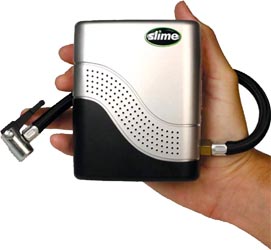
There are many electrical power pumps suitable for motorcycle use. These can be compact or not so compact and some of the economy ones found at your local large, discount department store (Wal-Mart) may just as well as the "motorcycle-adventure" versions.
Related Links:
CO2 Powered Inflators
These allow for quick inflation of tires without an air pump. They may be suitable as a compact single use system. And for tubeless tire users, this can be a safe and compact system for seating the bead on a flat tire.
You may need 3-4 cartridges to fully inflate a tire.
Inner Tube
An inner tube is going to be much better than a patch kit alone when you are stuck in the rain in the middle of the night trying to change a tire. Some riders only pack front inner tube which will double as a rear one.
Patch Kit
These are light and take up no room. They allow you to fix multiple flats as long as the tube is intact.
Bead Breaker
Used to break the bead on the rim. You can use a piece of wood and jumping power, your sidestand or one of the more purpose made devices on the market. You can also use an appropriately size C-clamp which can also double for other tasks.
Related Links:
Bead Lubricant
It is best to have a bottle of dishwashing soap or purpose made lubricant to help seat the bead. This makes life easier and may make the difference in you seating or not seating the bead when using a mini hand pump.
Related Links:
Tar Arns
Tire Irons are used to remove and install your tire on your rim. They can be simple iron rods, or even fancy lightweight titanium ones.
Related Links:
Motion Pro Tire Tools
Tire Pressure Gauge
Simple small tool allows you to measure your tire pressure.
Rim Protectors
These are plastic covers used by some riders to prevent scratching of their rims. This is really unnecessary unless, you are working on show bikes.
Rim Locks
These help keep your tires from spinning on your rim, especially when running tire pressures under 20 psi off road. Spinning your tires no only causes you to lose for of your rear wheel power, it also can rip our your valve stem and cause a flat. Plus, if you are running dual rim locks and stiff side-walled tires, you can often ride on a flat.
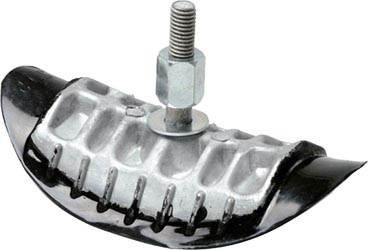
Alloy Rim Lock
Unfortunately, rim locks can make balancing the wheel and issue. If you run double rim locks as 180°, your wheel should be pretty balanced out, but this will make tire changing a bit more difficult. If you run a single rim lock or doubles at 120° tire changing will be easier than doubles at 180°, but you will need some balancing weights.
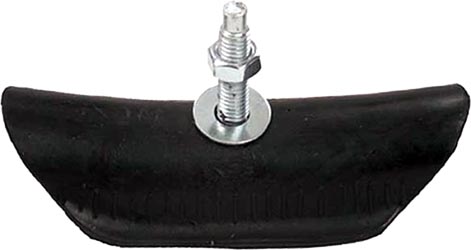
Rubber Rim Lock
They come in various forms including, alloy and rubber bolt on and as an inflatable rim locking inner tube.
Related Links:
Converting Spoked Rims into Tubeless Rims
Tubeless rims and tires have the advantage of not having a tube. This makes fixing a flat easier, since you can plug a hole without even taking the wheel off the bike. If you are using puncture sealing goo, this will work much better in a tubeless tire, as it is easier to occlude a hole in a tire than it is to plug a hole in an inner tube that can stretch and enlarge or tear open.
Sealing a spoked rim technically isn't that difficult to do. You just need to seal the area where the spokes enter the rim and you're done. The problem lies in the rim's design. Tubeless rims are designed with a small ~2-3mm safety ridge to trap the tire bead more securely. This ridge is why you have to "break" a bead. Some spoked tubed rims lack this ridge and rely only on the innertube to hold the tire in place. If you run lower air pressure while offroading and hit a bump, your tire will joggle a bit. If you are running a tubeless tire on a rim without safety ridges, you could break the bead and have an immediate flat. This doesn't occur so much with an inner tubed tire that depends on the innertube for air pressure and on the tire seal on the rim.
Some spoked wheels can be modified with a safety ridge, and you can always use a custom rim with or without spokes for a tubeless setup.
Another concern about tubeless rims and tires the the ability to fix a flat. The great advantage of fixing a flat with a tubeless tire is that you can just plug the tire and inflate it without taking the wheel off the bike. The potential problem lies in reseating the bead. This may be impossible with a bicycle or electric pump and you may need a CO2 cylinder inflator, a ratchet strap or a more exciting and less safe method such as using ether or fuel to create a small explosion in your tire. If an inner tube, you just have to remove the wheel, pull off one side of the tire, change the tube, reinstall the tire, avoid pinching the tube, pump and reinstall the wheel - which can all be done with simple tools and safe methods.
Yet anther concern involves rim damage. Even small dents in the rim can cause a tubeless tire to leak. This can be a problem if you are doing a lot of offroading.
Another concern is sealing a 21 inch front wheel. Some of the wheel fabricators out there don't do this and the narrow 21 inch wheels and tires may be a bit more susceptible to rim dings and impacts that will cause your tire to leak.
Related Links:
Supermoto 17 Inch Front Wheels
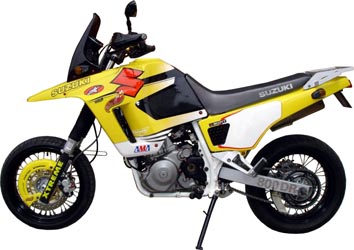
DR800 Supermoto
The taller 21 inch front wheel on the DR650 allows for better front wheel contact pressure on the ground which increases dirt traction. This taller front also helps you negotiate obstacles such as holes, rocks and trees. For a street only bike, the shorter wheel will allow you to run high performance road tires and will allow for better traction on the road during hard banking turns.

Since many dual sport bikes operate mostly on the roads, some riders replace their front wheels with a 17 inch supermoto wheel to allow for better high speed street handling or to increase the bike's supermoto abilities or looks.
Related Links:
Procycle Supermoto Wheel Sets, Rims & Parts
Snow and Winter Tires
Riding on snow and ice can be a challenge as poor traction and two tires aren't a good combination for stability. There are a few options that my help you push the limit and allow for some more cold adventures.
Tire Siping
Legend has it that in the 1920s, a gentleman by the name of John Sipe figured out that cutting slits in the bottom of his shoes improved his traction on wet bloody slaughter house floors, a particular work environment where falling on one's face is discouraged. In the US, tire siping eventually became somewhat poplar in the 1950s. And in the late 1970s, the U.S. National Safety Council performed performance tests for siped and non-siped tires on ice. In their tests, the siped tire groups were able to achieve 22% shorter stopping distances, 28% decrease in tire spinning and a 65% increase in breakaway traction. After these tests, the NSC endorsed tire siping but currently doesn't have a stand or seem to have any knowledge regarding siping performance.

Note the plethora of tiny zigzag slits in this Cager Snow Tire
If you look at high quality modern day snow tires for cars and SUVs, you'll see that they have thousands of tiny cuts in the tread, often zigzagging to increase the total linear length of these cuts. It is believed that all of these cuts provide an edge that grips down on wet and icy roads. Other tests have shown that sipes also decrease heat build up in tires and increase mileage, a rational for siping fleet trucks.
The only down-side to siping of automotive tires is the cost of siping, the the potential of chunking if used on rough roads, and the increased chance of picking up gravel on roads and making that all so annoying click click sound which worries many car drivers. The chunking concern is usually just that, a theoretical concern, and even offroad SUV tires seem to do well with proper siping.
In regards to siping of motorcycle tires, there doesn't seem to be that much published literature on the issue. Many racers do it to increase traction, but what do they know?
Many tire shops have tire siping machines that can quickly put hundreds of little cuts in your tread for a small fee. And if you like to do things yourself, no matter how daunting the task may be, you can use a utility knife or special siping knife to do the same task.
Related Links:
Motorang siping tool - German
"So fährt man Motorrad" by Ernst Leverkus
Hoosier Tire Siping and Grooving
Soft Winter Rubber
Automotive snow tires are made of softer compound and grip better than harder compounds, especially in the cold. There are few winter tires available for motorcycles and some riders have resorted to retreading tires with softer compounds for winter driving. This is more of a sidecar practice for those upper latitude hackers who like to intentionally ride in the snow.
Winter Knobbies
Aggressive knobbed tires will be able to bit into soft and wet snow and sometimes all the way through the snow into hard or mushy ground. The large knobs also allow you to place carbide stud or ice screw if you need to.

Kenda K-771
Unfortunately, on solid ice (white or black) or hard packed snow, aggressive knobs don't offer that much of an advantage over street tires and it might be time for some extra slow riding or something with more than two tires on the ground. If you can, it would be preferable to use a tire made from a compound that stays soft when it gets cold. The Kenda K771 and Trelleborg T-644 Army Specials reportedly stay soft even in the cold, affording you some traction where others fail.

Trelleborg T-644 Army Specials
The Trelleborg T-644 Army Special sizes translate to:
4,75-77 = 120/90-17
4,50-18 = 120/90-18
3,50-21 = 90/90-21
Carbide Studs
Mini carbide tire studs can and have been used on motorcycles with some success. The carbide wears somewhat like your tire and digs into ice.
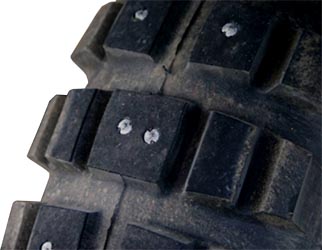
Depending on what type of riding you are doing will determine stud placement and amount. The tire above is for a bike with sidecar, so studs will work best in the center of the tire tread. For those on two wheels, better placement may be on the peripheral thread as you will need more traction when leaning to one side or the other and this will cause less slipping on dry highways.
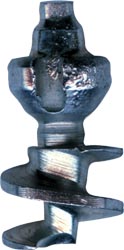
Most automotive carbide studs need a special stud gun to force the stud into the holes you drilled in your tire. This can be a long process and difficult process depending on the rigidity of your tire, tool available and your personality. If you take your tire to a shop experienced in studding tires, they can usually stud a pair of tires pretty quickly for a minimal fee which is most likely less than the cost of the tools you'll need. Do keep in mind that some tires just won't take studs and you may need to pre or re-drill and lube your tire to prevent the studs from popping back out. If you don't have a local tire studder or a stud gun, you can use self tapping studs like the one shown above..

Trelleborg T454
Trelleborb has several winter tires including the prestudded off-road only T-454 Winter Friction Spike Tire. This comes with some pretty aggressive knobs and studs which should bite into just about everything except pavement. Maxxis is another company with spiked tires.
Related Links:
Winterstuds Studs and spiked tires
advrider Stud Your Tires Tech Session
Ice Screws
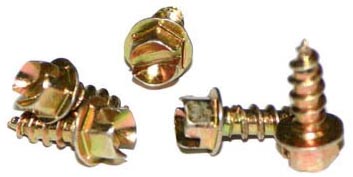
Sheet metal or purpose made ice screw can be put in your tires for some really aggressive ice traction. You simply screw these into your tire tread and ride.

Longer more aggressive studs used for snowmobiles can be drilled through the tire tread and then fixed with a lock nut. These will allow for incredible traction in the snow and even on frozen lake beds. On the road, they are like running on cleated shoes.
Related Links:
mfgsupply ATV Gold Ice Screws
advrider bolted tire
Fredette Racing Products Studded Ice Tires
Snow Chains

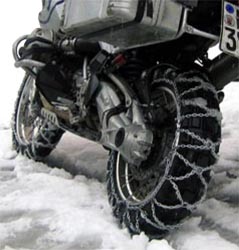
Wunderlich Snow Chains
Tire chains for motorcycles have been around for a long time but aren't as popular are they once were. This is in part to the increased use and popularity of SUVs in the snow and the decreased prevalence of sidecars and utility motorcycles on today's roads. Because of this and other factors, it can be difficult to find a local tire chain distributor that has knowledge of motorcycle chains much less an inventory or proper sized chains. Still, there are usable chains out there and shops that build custom chains for cars and trucks can just as easily build a set for your bike.
Once you find a shop able to build chains, you need to determine if they can build the chains you want on your bike. The ladder style chains made from larger links used on big rigs to meet minimum highway and longevity requirements won't give you as smooth a ride as diamond pattern chain made from smaller sized links of chromium magnesium. Then once you've determined how much of a chain you want, you have to figure out if the chain shop is willing to make a set of bike chains do to their priorities, fabricating comfort level and fear of potential liability from the ensuing crash you will have shortly following hitting ice with their chains. And their concerns are not always unfounded as chains may increase your traction on snow and ice, but you are still on snow and ice with just two wheels and the chains will make bare pavement riding quite challenging. That, and we live in a litigating world full of fools and lawyers.

Sand Paddles
If you can't find chains made specifically for motorcycles, you may have better luck with a set of car chains. If you look hard enough, you should be able to find a pair the will work on motorcycle tires, which will most likely have a lot sag. You can either take out extra links, or use extra straps and tensioners to tighten things up a bit. If you take out links in your chain, remember that the traction links that come in contact with the road are hardened metal. You can cut and re-link to your hearts content, but don't place any material other than the hardened metal links where they will contact the road - in other words, relink the tension links and not the traction links.

Snow Claw
If you don't want or can't afford (price wise or weight wise) a set of complete chains, you can still get a fair amount of traction from multiple independent sections of chain or traction plates wrapped around your rim. Riders have also tried coiling a single length of chain all the way around the perimeter or the the tire, wrapping it around the rim as they go.

You can attach a short length of chain around your tires with a tension strap or even just some nylon cord and good tension knots. It would be an easy DIY project to make a set of these, and they won't take as much room as a set of complete chains would and would be easily removable, unlike studs or ice screws.
Wunderlich Snow Chains:
For 17 inch wheels (150/70) PartvNo 9002195
For 19 inch wheels (110/80) PartvNo 9002196
Related Links:
Snowmobile Ice Studs
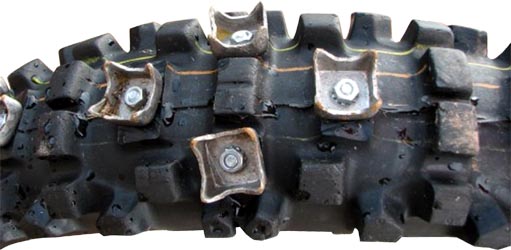
This is where traction options begin to get a little extreme. Riders have used large teeth like studs used in snowmobiles on their bikes. This creates a highly aggressive bite that will tear up just about anything your bike runs over. Of course, the road handling qualities of this option are a bit entertaining.
Related Links:
Ski and Tracks
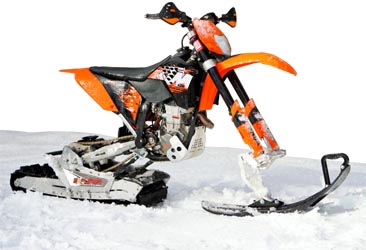
Nothing gives you traction in the snow like tracks, that's why Eskimos use snowmobiles and Stalin used tanks. So a continuous track is one of the most significant ways of increasing your bike's traction on snow and ice. And use of skids in the front allow you to steer while still floating over the snow. Unfortunately, the downside of using skids is that they don't work well on dry paved roads and you most likely won't be able to use these on roads in the free world, which is ironic in some ways.
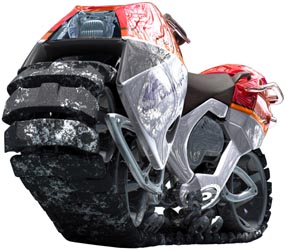
Hyanide
A step up from a half track half skid with a bike feel would be using a single large articulation track that would allow you to steer the "bike" while on various surfaces including regular roads. Or you could go with a trike or tank feel and just get a surplus military tracked vehicle.
Related Links:
Third Wheel
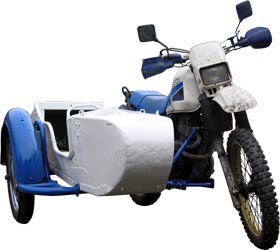
Polish Hack on DR600
Nothing will give your DR650 more stability in the snow than another point of contact, such as a sidecar (AKA Hack). These were once much more popular for winter travels than they once were, and are still common in the snowy and less economically privileged regions of the world. The third wheel acts as an anchor on slippery surfaces, affording more traction and should you slide, you'll most likely slide upright.

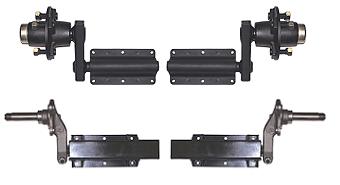
Rubber Torsion Half Axles
Hacks can be made from other sidecar rigs such as the Russian Ural, purchased from one of the few sidecar fabricators still around or made at home with fancy suspensions and steering or with very simple suspension parts such as light duty trailer rubber torsion axles. And if a passenger setup isn't utilitarian enough for you, you can build a hack around a utility box and place a winch on it.
Related Links:
Automobile and Truck Tires
The tires first used on motorcycles were actually just narrow car tires. And as tire technology has advanced over the year, tires designed for motorcycle use only were developed. As automobile tires become wider, the shape of motorcycle tires remained narrow and developed a rounded contour for better contact and traction during turns. The motorcycle sidewalls were also beefed up to allow for longer life, better wear and for structural integrity should the tire get a flat.

Modified Truck tire for Offroad Traction
There are many riders that use tires designed for automobile and truck use on their bikes. This can be a controversial topic but most agree that use of tires not designed specifically for motorcycle use on a bike is unsafe. On turns, the contact patch is too small for safe cornering and wear and if the tire loses air pressure, it will relatively immediately flatten, creating a potential unsafe event. But for the "Dark Side" riders that actually use auto tires and have real world experience, they argue that the wider automobile tires provide better traction and wear for highway riding and actually corner quite well but require additional counter steering. They are also generally used on cruisers that aren't able to lean much do to low hanging foot pegs, pipe and unnecessary chrome.
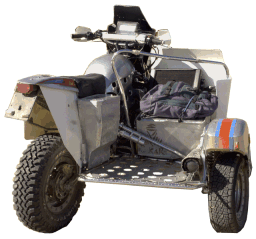
For sidecar rigs, car and truck tires make a lot of sense. These tires allow for a much larger contact patch of tire to the road compared to a rounded bike tire, are more affordable and last much longer.
For a DR650, the stock rear suspension doesn't allow fitment of modern day car or truck tires. You would need to find an old tire (and possibly retread it) or modify the suspension to allow for a wider tire.
Related Links:
Car vs Bike Wheels
Even though motorcycle and car wheels come in 15, 16 and 17 inch sizes, the rims are actually made to different size specifications. A 15 inch car rim has a mounting diameter that is less than 15 inches (14.968") and a 15 inch motorcycle rim has a mounting diameter that is actually over 15 inches (15.080") which makes mounting a 15 inch car tire on the motorcycle rim difficult and mounting a motorcycle tire on a car rim dangerous. Some 15 inch motorcycle wheels are thick enough that they can be lathed down if car tires better; others are not. Likewise, 16 and 17 inch rims for cars and motorcycles differ, yet riders are still able to make many auto tires work on motorcycle rims. Other looking for a car tire solution will convert a car rim to run on their bikes.
Related Links:
Rear Tire Use in Front
Certain motorcycle tires are not available for front use. So, many motorcycle and sidecar riders use a rear tire in the front. When doing so, one should fit the tire so that the rotating direction indicated on the tire sidewall goes in the reverse direction of rotation of the front wheel.
Related Links:
Flat Protection
There are several systems on the market to all motorcycle and mountain bikes to ride over thorny areas and keep on going after a tire puncture.
Foam Tubes
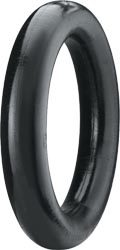
Michelin Bib Mousse Flat-Proof Competition Foam Tube
Run-Flat foam tubes (Michelin Bib Mousse, Tech Tubes, Moose Racing Blue Tubes and Dunlop Crescent Mousse tubes) fill the inside of the tire and can have has a pressure equivalent of approximately 13 psi (Michelin Mousse). They are made for offroad use only but are said to be capable of 80mph speeds. And as you can imagine, if a nail, stick or other undesirable object penetrates your tire, there isn't any air pressure to lose and the foam will continue to keep its shape.
Related Links:
Tire Balls
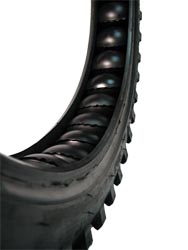
Tire Balls
Instead of one giant foam tube, riders have tried filling their tires with tennis balls or pneumatic air-cells. This helps give the tire a pressurized feel and allow you to continue to ride as only a single ball will deflate instead of your entire tire. Tennis balls of course don't deflate when punctured.
Related Links:
Self-Sealing Tire/Tube Slime/Gel

Slime Tube Sealant
There are a few tire sealant make for car, bicycle and motorcycle tires/tubes. Some of these are designed to be used after you get a flat and other are prophylactic and seal the tire or tube after a puncture. Rhino Tire and other companies have marketed puncture sealing gels for autos, motorcycle and bicycles. They have some pretty impressive videos that seem a little too good to be true but might be worth looking into.
Related Links:
Please feel free to link to this site so that others can find it. It's easy to link to this site, just copy one of the texts below onto your web page:
Copyright © 2000-2014